World’s Largest Wetlands on Fire
Air Date: Week of September 18, 2020

Satellite imagery of the wildfires in the Amazon rainforest (Photo: NASA Johnson, Flickr, CC BY-NC-ND 2.0)
As wildfires blaze across the West Coast of the U.S., Brazil grapples with its own fires, in its massive Pantanal wetlands and the Amazon rainforest. Host Steve Curwood speaks with biologist Daniel Nepstad, President of the Earth Innovation Institute, about the role of climate change in the wildfires and how they’re impacting Brazilian biodiversity, ecosystem services, and local communities.
Transcript
CURWOOD: It’s Living on Earth, I’m Steve Curwood.
[Pantanal sounds]
CURWOOD: The Pantanal in South America is the largest wetland in the world. It lies mostly within Brazil on the Southwest border of the Amazon rainforest and at more than 42 million acres the Pantanal is roughly the size of Florida. Home to jaguars, the endangered maned wolf, and more than 650 species of birds the Pantanal is an ecological jewel. The World Wildlife Fund for Nature recently reported that in the past 50 years more than two thirds of animals have been lost around the planet, and in South America and Caribbean animal numbers have declined by more than 90 percent, making the Amazon and the adjacent Pantanal key refuges. In the Amazon rainforest farmers burn to open space for crops, a practice that degrades the rainforest. In the grassland Pantanal ranchers generally have used fire responsibly to clear dead forage during the annual dry season. But this year the equation has changed. Historic drought has led to out of control wildfires, and these record setting blazes have already scorched 20% of the Pantanal. For more I’m joined now by biologist Daniel Nepstad, president of Earth Innovations Institute. He’s also a lead author for reports of the Intergovernmental Panel on Climate Change. Dan, welcome to Living on Earth!
NEPSTAD: Thank you. It's wonderful to be here.
CURWOOD: The Pantanal is teeming with biological diversity please describe some of the animals and plants that live in this sometimes wet sometimes dry land.
NEPSTAD: Yeah, I've lived for 12 years in the Amazon forest region and in that time, I've probably seen a Jaguar or five times in the wild in the middle of the forest. In the Pantanal I've been there a few weeks, and I've seen dozens of jaguars, dozens of giant anteaters, capybaras, caiman, these alligator reptiles. Sometimes you'll come up to a lake, you'll be riding a horse through the Pantanal on one of these Pantanero ranches, and there'll be 100 cayman, you know, five feet long lined up along a pond. It's just the wildlife blows your mind it’s just everywhere. I was crossing a little stream I noticed that there is this peculiarly shaped log in the stream and it was an anaconda that was about 25 inches in it's thickest spot it's probably where it ate a capybara. So it's it's just teeming with wildlife because with that seasonal rhythm of flooding and ebbing of the river, you get tremendous productivity of grasses of aquatic plants of fish. Piranha are very common there. The hyacinth macaw, the world's largest macaw that's its biggest population in the Pantanal giant river otters, the jabiru stork is very common there, the marsh deer. So it's just there's 1200 different types of vertebrates there and many of them are rare. A lot of them are not on the brink of extinction, just because there is a lot of intact, Pantanal remaining, and many of the species do leak over into some of the surrounding biomes.
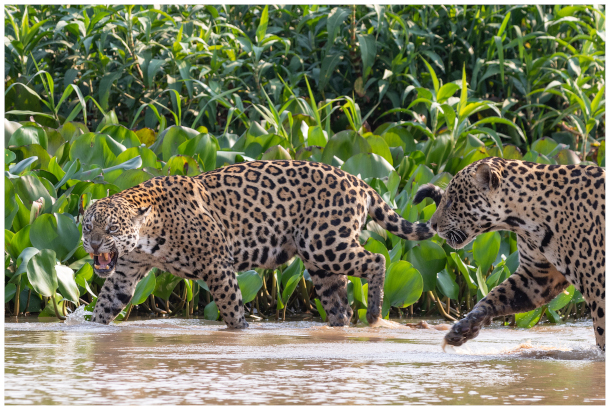
The Pantanal wetlands are rich with biodiversity, and filled with jaguars. Unfortunately, the wildfires are threatening their existence. (Photo: Martha de Jong-Lantink, Flickr, CC BY-NC-ND 2.0)
CURWOOD: So Dan, it's the world seems to be burning up right now. We've got fires raging across the West Coast where you are as well as in Brazil, specifically in the Pantanal wetland, the largest wetland in the world. We'll talk more about the fires in a moment. But please, could you describe the Pantanal wetlands and why it is burning up right now?
NEPSTAD: Well, the Pantanal is, as you say it's the world's largest wetland and it's a seasonal wetland so that in the rainy season, the Paraguayan and Paraná Rivers fill up with water and they flood most of the Pantanal. And so the cattle herds at the Pantanal are literally wading through water and the cowboys with horses wading through water as they they ranch the Pantanal, they graze, the Pantanal and then the water goes down and it gets really dry and that's when the fires come in.
CURWOOD: So this year I gather is worse than others. What are we looking at right now?
NEPSTAD: We're looking at the the worst drought hitting the Pantanal and in about half a century, 47 years and river water levels are way down, the wells are drying out. And because of that the vegetation that can usually still tap into the water that's in the soil below the ground surface is parched. And when it's parched, and the temperatures are high, it catches fire and those fires get out of control very easily.
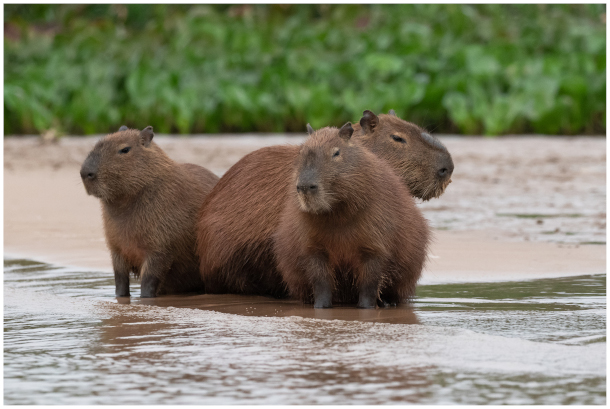
Brazilian wildfires are threatening capybara communities native to the Pantanal wetlands. (Photo: Martha de Jong-Lantink, Flickr, CC BY-NC-ND 2.0)
CURWOOD: Now, to what extent are these fires intentional?
NEPSTAD: Well, the Pantanal has got a culture called the Pantanero culture. It's mostly cattle ranchers, who have adapted their cattle management systems to this seasonal rhythm of the rising and ebbing flow of the river and part of that management system is burning. And they will burn the pastures when the risk of the fires is not too high, and a lot of these are native grasslands. And it's really quite a sustainable system. The problem is when you hit that system with an extreme drought, like this year where the fires are starting, not just from those pasture management fires set intentionally, but they're being set accidentally and fires escaping their intended boundaries. So it's what is usually a fairly controlled fire burning season that's part of the the, the pasture management this year, it's just gone haywire. They can't control the fires.
CURWOOD: And by the way, why does fire manage the grasslands?
NEPSTAD: In the Pantanal system. So these grasslands get flooded every year they get a little injection of sediment from the river that brings in some nutrients and it goes down and when you burn the pasture, you get rid of the old growth, the woody shrubs that are invading the pasture. And the grasses come back greener and you can actually get better cattle production off of those recently burned pastures. If you don't have that input of river sediments every year, then the fires are actually a loss of nutrients and it's really running down the fertility of the soil. But in this case, it works pretty well.
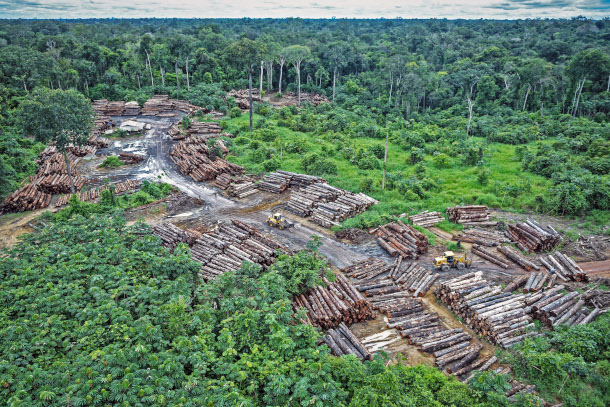
Illegal deforestation on Pirititi Indigenous lands of the Amazon rainforest. Since 2018, over 4 million hectares of land have been cleared. (Photo: Brazilian Environmental and Renewable Natural Resources Institute, Flickr, CC BY 2.0)
CURWOOD: So Dan, what is the relationship between the Pantanal and the Amazon rain forest and what are the links, if any, in terms of the fires?
NEPSTAD: Yeah and so first of all, the Amazon if you think of the the northern part of South America, you've got these trade winds coming in from the east blowing West they take in all this moisture, then they cross the Amazon and that wind picks up more moisture. The wind hits up against the Andes and it either bends north or bend south. The airmass Is that bend South carry that water vapor into the Pantanal and into the Sahado Woodlands of Central Central South America and therefore they're a big source of rainfall. So there's a water connection between the Amazon in the Pantanal that's quite strong. A portion of the watershed of the the Pantanal the Cuiabá River for example that comes in to the Pantanal is draining it reaches up into the edge of the Amazon. The fires themselves first of all, there's a huge difference, the Amazon forest naturally burns about every five to 700 years. In other words, pre Colombian times that was the rhythm. It's a very unbelievable and infrequently burned forest. It's just so damp the canopy is so dark, so dense and I've set hundreds of fires Amazon forest as a scientist, and they almost always go out immediately, you know, they can burn for maybe a minute. It's just soggy and what happens during an extreme drought event is that sogginess disappears and it sounds more like a main forest walking through a main forest and the rustling of leaves, and those forests become flammable. And that happens every few years and it's more and more frequent and that's what we're seeing this year in the southern part of the Amazon. The Pantanal In contrast, is really mostly a large grassland and grasslands every year you can set on fire. In fact, much of the Pantanal is burned for the pantanero cattle management systems which rely on mostly native grass, although some African grasses are being planted there as well. So you've got a the Pantanal burns naturally and through cattle management and the forest there tend not to burn. And because the management system keeps those fires out of the forest, but they are flammable and this year, they're burning, everything is burning.
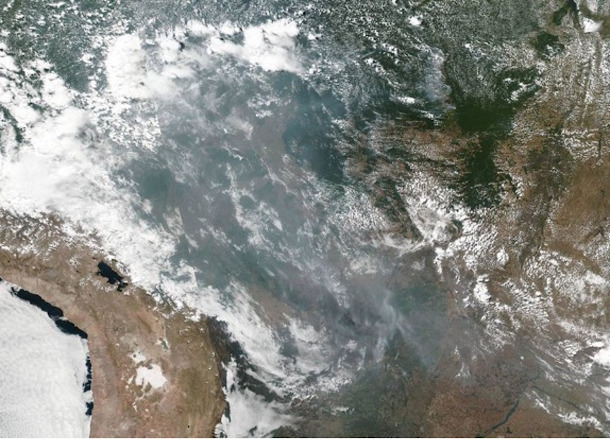
Satellite imagery of cross-country wildfires in the Amazon rainforest. (Photo: NASA, Public Domain)
CURWOOD: How concerned are you about this level of burning in the Pantanal now?
NEPSTAD: I think the really impactful way we're experiencing climate change is through these crazy fires, fires that are burning out of control because the vegetation is parched. And the temperatures the winds, the dry lightning like we had and here in California, are just much more frequent and higher and more intense and more violent. And in the Pantanal, the connection to climate change is not as direct it's really a warming of the tropical Atlantic Ocean north of the equator. That's part of this longer multi-decadal oscillation that we've had since the 90’s but climate change is feeding into that. In fact, climate change may be one reason we have this Atlantic oscillation, and it could be that it, it makes it stick around longer. And so it's a complex change underway. But what's really frightening to me and just living in this smoke here in California, and being part of a fire evacuation a few weeks ago, our lives are changing because of climate change. And this is a taste of things to come.
CURWOOD: Let's talk for a moment about the Amazon as a whole. I think it's safe to say the Amazon is the world's largest tropical rain forest and it's a huge carbon sink. I believe that it absorbs what on the scale of 5% of annual carbon emissions and puts out as much as 20% of the planet's oxygen. How does all this fire activity affect the Amazonian rainforest, ability to be a carbon sink?
NEPSTAD: The Amazon as you say, It's just in the trees of the Amazon, there's about 100 billion tons of carbon. And when that carbon is turned into carbon dioxide through burning or through decomposition, that means that there's a potential of nearly half a trillion tonnes of co2 in the Amazon forest. That's about a decade's worth of human caused carbon pollution today, if a significant chunk of the Amazon rainforest is destroyed, it's going to be a lot harder for us to avoid the extreme impacts of climate change, let alone the more guaranteed very dangerous impacts of climate change. So it's a big deal.
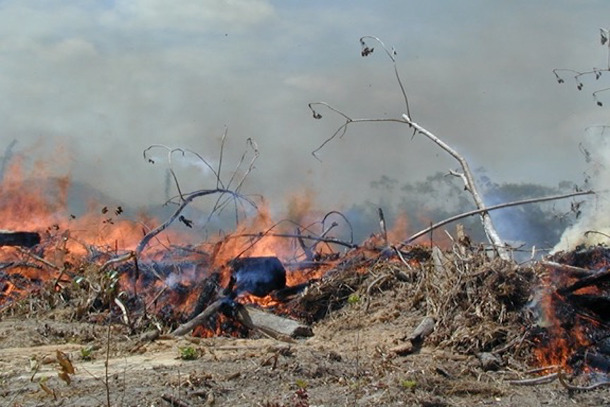
An increase in drought is making the Amazon rainforest more vulnerable to fires. (Photo: Doug Morton, NASA)
CURWOOD: So to what extent are you telling me that if we keep going, we're going to hit a tipping point where the Amazon and for that matter, other forests will become grasslands? How true is that and if so, where are we right now do you think in that process?
NEPSTAD: So there's really good science showing that when you clear the forests, you get less rainfall. And the big question is at what scale? We already have evidence that temperatures are rising and rainfall the dry season is longer in the eastern, southeastern part of the Amazon where most of the deforestation has taken place. And the big question is, are we going to reach a level where there's so much clearing that the entire Amazon rainfall system is inhibited so that there's not enough water, rainfall to get those forests through the dry season each year? And that is a bit up for grabs. You know, some scientists some models show we would hit that threshold. At 40% loss. We're at 17% currently, others say it's 25% others say it actually is not going to happen. There's some model experiments that do not give us a tipping point. I think the precautionary principle would say, what we need to do in the Amazon is slow deforestation and end it and reverse it. And there's actually a huge opportunity to do that, by in the case of Brazil, where we have two thirds of the Amazon forest, implementing the law 51% of the forests of the Amazon are protected in some way. Let's make sure those indigenous territories and parks are really well managed and not being invaded. 80% of every farm in the Amazon is supposed to be set aside as native forest. Let's make sure that the farmers who want to do that and are doing that are recognized and rewarded in some way. And currently, they're not if I'm a farmer in the Amazon, and every hectare of forest on my farm is going to be worth one fifth the value of the cleared area I have. And so the more I clear, the more value my farm has, and I'm thinking of passing this along to my kids, right? The value of that same Hector of forest $200 in the land market is $50,000 in damages done to the global economy, if it's cleared. And so that should be one of the easiest things to solve in the world, right? Where we can keep a hectare of rainforest standing by closing the gap between $200 and $1,000 when it's clear, that needs to be called out.
CURWOOD: Daniel Nepstad is president and founder of Earth Innovation Institute. Dan, thanks so much for taking the time with us today.
NEPSTAD: Steve, it was my pleasure. Thank you.
Editors Note: The Amazon rainforest does not produce 20% of the world's oxygen. The Amazon rainforest accounts for 20% of the land's surface photosynthesis on the planet but it consumes as much oxygen as it produces.
The biggest contributor to Earth's oxygen supply is actually the ocean.
The Amazon is a crucial carbon sink, meaning if it were to completely burn, atmospheric CO2 concentrations would increase by around 10%.
Learn more at the link below.
Links
About the Earth Innovation Institute
Daniel Nepstad’s NY Times Op-Ed | “How to Help Brazilian Farmers Save the Amazon”
CNN | “Tens of thousands of fires are pushing the Amazon to a tipping point”
National Geographic | "Why the Amazon doesn't really produce 20% of the world's oxygen"
Living on Earth wants to hear from you!
Living on Earth
62 Calef Highway, Suite 212
Lee, NH 03861
Telephone: 617-287-4121
E-mail: comments@loe.org
Newsletter [Click here]
Donate to Living on Earth!
Living on Earth is an independent media program and relies entirely on contributions from listeners and institutions supporting public service. Please donate now to preserve an independent environmental voice.
NewsletterLiving on Earth offers a weekly delivery of the show's rundown to your mailbox. Sign up for our newsletter today!
 Sailors For The Sea: Be the change you want to sea.
Sailors For The Sea: Be the change you want to sea.
 The Grantham Foundation for the Protection of the Environment: Committed to protecting and improving the health of the global environment.
The Grantham Foundation for the Protection of the Environment: Committed to protecting and improving the health of the global environment.
 Contribute to Living on Earth and receive, as our gift to you, an archival print of one of Mark Seth Lender's extraordinary wildlife photographs. Follow the link to see Mark's current collection of photographs.
Contribute to Living on Earth and receive, as our gift to you, an archival print of one of Mark Seth Lender's extraordinary wildlife photographs. Follow the link to see Mark's current collection of photographs.
 Buy a signed copy of Mark Seth Lender's book Smeagull the Seagull & support Living on Earth
Buy a signed copy of Mark Seth Lender's book Smeagull the Seagull & support Living on Earth

